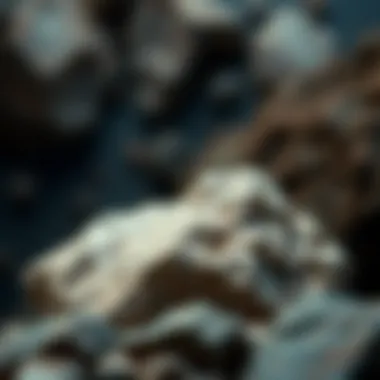Identifying Rocks: A Comprehensive Guide for Enthusiasts


Intro
The world beneath our feet tells a story layered with years of earth’s history, waiting patiently for curious minds to unearth its secrets. Each rock you stumble upon can be a prized possession, a collectible steeped in the rich fabric of our planet's narrative. This guide aims to arm both budding enthusiasts and seasoned collectors with essential knowledge, tools, and methods to discern what lies in their hands—whether it be a simple chunk of granite found in your backyard or a rare fossil that holds scientific inquiry.
History and Origins
Overview of Collectibles, Rocks, and Fossils
Rocks and fossils have fascinated humans for ages. From ancient civilizations using them for tools to modern-day collectors admiring their beauty, these natural treasures hold a special place in human culture. Many cultures, including the Chinese and Native Americans, have used geological specimens in spiritual practices and healing rituals. For example, Native American tribes considered specific stones to possess healing properties, further intertwining their existence with cultural significance.
Not merely objects of curiosity, these geological formations shed light on geological processes that have occurred over millions of years. Indeed, each rock type tells a tale—be it igneous, metamorphic, or sedimentary—rooted deeply in the earth's transformations. Furthermore, fossils serve as witnesses to the past, showcasing life forms that once roamed the planet.
Historical Significance and Cultural Impact
Various cultures have revered certain rocks; they’ve been sources of mythology, symbolism, and knowledge. Take obsidian, for instance. This volcanic glass, with its sharp edges, has been used by ancient civilizations across the globe for tool-making, and it caught the fascination of modern artists for its mirror-like sheen. Moreover, there are ancient civilizations that built monumental structures from stones like limestone and granite, emphasizing not only their value as resources but also their cultural representation as emblems of strength and endurance.
From museum displays to local geology clubs, the allure of rocks resonates strongly even today. Collectors often debate the meaning of a piece or its implications for understanding geological epochs, and this discussion serves as a bridge between the layman and the expert.
Identification and Classification
Guide to Identifying Rocks and Fossils
Identifying a rock or fossil can initially seem like searching for a needle in a haystack, but with a keen eye and systematic approach, it becomes approachable. Here are some steps to simplify the process:
- Observe Color: Differences in hue can indicate the mineral composition.
- Check the Texture: Feel the rock. Is it smooth or rough? Crystalline or glassy? These details can provide clues.
- Test Hardness: Use the Mohs scale for a quick hardness test. Can it be scratched with a fingernail, or is it tougher than glass?
- Examine the Grains: For sedimentary rocks, grain sizes can tell you about the environment where they formed.
- Look for Layers: Stratification is a key indicator for understanding sedimentary processes.
These aspects gather clues that lead you towards determining whether you are looking at a common stone or an unusual mineral.
Common Types and Variations
The realm of rocks is diverse, encompassing a plethora of types with unique characteristics:
- Igneous Rocks: Resulting from cooled magma, examples include basalt and granite—often found near volcanic regions.
- Sedimentary Rocks: Formed from particle accumulation over eons. Think of limestone and sandstone, commonly seen in riverbeds.
- Metamorphic Rocks: Created under heat and pressure. Marble and schist are beautiful examples, often used in sculpture and architecture.
Fossils, on the other hand, come in various forms. You might encounter:
- Imprints: Such as footprints left by ancient creatures.
- Amber: Plant resin that preserved insects for millennia.
- Mold and Cast Fossils: Represented by cavities left after organisms decay.
To dive deeper into this fascinating topic, consider visiting resources like Wikipedia for foundational knowledge or engaging on platforms like Reddit to discuss findings with fellow enthusiasts.
Prologue to Rock Identification
Understanding what we are looking at when we stumble upon a rock, be it on a casual hike or while digging in the backyard, is more significant than many might think. Rock identification is not merely a hobby; it’s a gateway into the earth’s history. Each rock holds a story—a story about the environment in which it was formed, the geological processes it has endured, and the time scales involved. By diving into rock identification, we unlock the secrets of our planet, enhancing our appreciation for nature’s artistry.
Identifying rocks can help us comprehend broader geological concepts, like plate tectonics, erosion, and volcanic activity. When collectors, whether novices or seasoned enthusiasts, learn to identify rocks accurately, they become better equipped to make informed decisions about their collections. It allows for an understanding of where a rock may have come from, its age, and what minerals it contains. Each of these aspects contributes to the larger puzzle of how our world functions.
In this section, we’ll delve into the basics of rock formation and classification. We aim to provide you with the knowledge necessary to differentiate between various rock types, appreciate their unique characteristics, and, ultimately, gain a deeper understanding of the geology around us.
Understanding Rocks
To dive into rock identification, it's important to grasp some foundational concepts related to rocks themselves. Rocks are generally classified into three main types: igneous, sedimentary, and metamorphic. Each type has distinct features and origins:
- Igneous Rocks: Formed from the solidification of molten magma or lava, these rocks can be either intrusive (formed within the Earth) or extrusive (formed at the surface).
- Sedimentary Rocks: Created through the compression and cementation of mineral and organic particles, they often preserve fossils and offer insights into historical environments.
- Metamorphic Rocks: Resulting from the transformation of existing rocks due to heat, pressure, or chemically active fluids, they showcase the dynamic nature of geological processes.
Recognizing these differences lays the groundwork for more specialized identification methods.
Importance of Rock Identification
The ability to identify rocks can enrich one's understanding of both the natural world and the historical narrative embedded within the earth's crust. There are numerous reasons why rock identification holds importance:
- Educational Value: Learning to identify rocks enhances knowledge about geological processes, thus fostering a greater appreciation for earth sciences.
- Conservation Awareness: Understanding the origin and distribution of various rock types can aid in the preservation of natural resources and biodiversity.
- Hobby and Collecting: For many, rock collecting is a rewarding hobby that brings joy and fulfillment. Proper identification aids in creating a more meaningful collection.
- Practical Considerations: Certain rocks can have practical uses, such as building materials or gemstones, making identification a valuable skill in various industries.
"By recognizing the rock beneath our feet, we connect with nature on a more profound level; it’s not just a stone—it's the earth speaking to us."
By taking the time to learn these fundamental aspects of rock identification, one can appreciate not just the physical aspects of rocks but also the larger context in which they exist. This journey through identification can lead to a richer exploration of the natural world.
Types of Rocks
Understanding the types of rocks is crucial for anyone interested in geology, whether you’re a seasoned collector or just starting out. Each type—igneous, sedimentary, and metamorphic—carries its own unique properties, history, and significance in our planet’s geological narrative. By knowing the differences among these rock types, you can delve deeper into their origins and relevance in the natural world.
Igneous Rocks
Igneous rocks are formed from the solidification of molten lava or magma. They can be divided into two main categories: intrusive and extrusive igneous rocks. Intrusive rocks solidify beneath the Earth’s surface, which means they cool slowly, allowing larger crystals to form. Granite is a prime example of an intrusive rock, boasting a coarse texture and a composition rich in silicate minerals. Extrusive rocks, on the other hand, erupt onto the surface where they cool much quicker, resulting in smaller, often glassy crystals. Basalt, prevalent in many oceanic crusts, showcases this characteristic.


Knowing how igneous rocks are formed helps collectors gauge their environments when they come across a specimen. Do you find a stone that cooled quickly, or one that took its sweet time? Recognizing these differences can help paint a picture of ancient volcanic events.
Sedimentary Rocks
Sedimentary rocks arise from the accumulation of sediments—pieces of minerals, organic matter, and other materials that have weathered from older rocks. These sediment layers are compacted and cemented over time, often resulting in visually appealing structures like fossils or ripples from ancient water beds. Sandstone, limestone, and shale are common types in this category.
What makes sedimentary rocks particularly fascinating is their ability to unlock stories from the past. A layer of limestone might imply a former marine environment, while shale could indicate periods of low energy, perhaps a swampy area. Collectors often look for unique patterns, fossilized remains, or even distinct colors that indicate the conditions under which these rocks formed.
Identifying sedimentary rocks not only enriches your geological knowledge but also equips collectors with the ability to interpret Earth’s history through its layers.
Metamorphic Rocks
Metamorphic rocks are essentially the reworked siblings of igneous and sedimentary rocks. They undergo metamorphism, a process transformed by intense heat and pressure, often deep within the Earth. This transformation alters their mineral composition and physical properties. Take marble, for instance: It starts as limestone and, under the right conditions, becomes a metamorphic rock with a fine, crystalline texture. Another exemplary metamorphic rock is schist, known for its layered appearance and shiny crystals.
The ability to identify metamorphic rocks opens up new avenues for collectors. These stones can vary tremendously based on their parent rocks and the conditions they’ve experienced. Understanding the differences between schist and gneiss, for example, can provide insights into the tectonic forces at play. Every rock tells a story of pressure, heat, and time.
Key Characteristics of Rocks
Understanding the distinct characteristics of rocks is crucial for anyone involved in rock identification, whether a curious amateur or a seasoned collector. Each characteristic tells a story about how the rock was formed, what environment it comes from, and even its potential uses. Thus, recognizing these key traits can help you classify rocks correctly and appreciate their uniqueness.
Color
Color is often the first thing we notice in a rock. It's a visual melody that paints a picture of the rock's mineral composition and its environmental story. Various minerals create a palette from earthy browns to vivid reds and deep blues. For instance, a quartz crystal can appear colorless, but impurities can give it shades of purple or yellow, as seen in amethyst and citrine.
However, it's essential to note that color can be misleading. Weathering, oxidation, or other factors might change a rock's surface hue while leaving its core unchanged. So, don't rush judgment based solely on color; it’s a good starting point but not the whole picture.
Interesting Fact:
Rock types like basalt are typically dark due to their high iron and magnesium content, while granite tends to be lighter because of the presence of quartz and feldspar.
Texture
Texture refers to the feel of the rock's surface and its internal structure. Is it smooth like glass or grainy like sandpaper? The texture can reveal how a rock was formed. For example, igneous rocks, like pumice, cool quickly from molten lava, resulting in a frothy texture. Meanwhile, sedimentary rocks often have a layered or banded appearance because they form from the accumulation of sediments over time.
Texture also relates to grain size. Larger grains indicate slow cooling, like with granite, while finer grains suggest rapid cooling, as seen in rhyolite. Pay attention to texture; it’s a vital clue in your identification journey.
Hardness
Hardness measures a rock's resistance to scratching and abrasion, typically assessed using the Mohs scale. This scale ranges from talc, the softest at 1, to diamond, the hardest at 10. Knowing the hardness of a rock can help you understand its durability and potential for use in construction or jewelry. For instance, if your rock scores a 7 on the Mohs scale like quartz, it's relatively hard and durable. In contrast, a rock that registers a 2, like gypsum, might crumble under pressure.
Remember, hardness is about relative resistance, not an absolute measure.
Each mineral's position on the scale provides insights into its physical properties, helping you categorize the rock more effectively.
Mineral Composition
Every rock is a collection of minerals, and understanding its mineral composition is like reading a rock's biography. The minerals present indicate how and where the rock formed. A metamorphic rock, for example, may contain minerals like garnet or mica, formed under high pressure and temperature.
It's worthwhile to use a hand lens to examine the individual minerals. Learning to recognize common ones—like feldspar, quartz, or calcite—can enhance your identification skills. Remember, the mineral makeup is intertwined with the rock's overall characteristics and its geological significance.
By analyzing these key characteristics, you'll not only enrich your rock collection but also gain a deeper appreciation for the beautiful complexities of nature. As you continue your journey, keep these traits in mind and let them guide your exploration and understanding of the rocks you encounter.
Classification Systems
Understanding rock classification is key to grasping the larger picture of geology. Classification systems help enthusiasts and professionals alike put rocks into context. Whether you're staring at a rock on a riverbank or weighing options for your next collection piece, knowing how to classify a rock can shape your experience and deepen your understanding.
The Mohs Scale
The Mohs scale is a classic system used to rank minerals based on their hardness. It’s not just a fancy list; it’s a handy tool for rockhounds everywhere. Spanning from talc, the softest mineral rated as 1, to diamond, the hardest at 10, this scale provides a clear-cut way of understanding a rock’s ability to resist scratches and wear.
Why should you care about hardness? In simple terms, hardness can tell you a lot about the rock’s durability and potential uses. For example, if you find a rock that scratches glass easily, you could suspect it may be quartz or something harder, which is pivotal for gear-making.
“Hardness is not just a number; it's a rock's personality.”
Testing Hardness
To put the Mohs scale to work, you can do a simple scratch test using common objects. Here’s a quick breakdown:
- Talc (1) - Soft as butter; will get scratched by a fingernail.
- Gypsum (2) - A little tougher; won’t yield to your nail but can be scratched by a copper coin.
- Calcite (3) - Scratches with a knife blade and scratches glass.
This testing is a straightforward method to build your rock identification skills and make the whole process of classification a bit more hands-on.
Petrographic Classification


Diving deeper into rock classification, we come across petrographic classification. This method focuses on the microscopic features of rock samples. It separates rocks into three main categories: igneous, sedimentary, and metamorphic, based primarily on mineral composition and texture.
In petrography, thin sections of rocks are examined under a polarizing microscope. This allows for a detailed view of the minerals present, their interrelationships, and the rock's overall structure. It’s practically like looking at a different world all together. A granite may appear as just a gray rock to the naked eye, but under the microscope, you may find microcrystalline quartz and feldspar, revealing the rock's history.
Importance of Petrographic Classification
Understanding the petrographic classification opens up a wealth of information:
- Composition Highlights: Recognizes which minerals are prominent and what that implies regarding the rock’s origins.
- Textural Analysis: Helps in understanding the formation environment - whether it originated from volcanic activity or sedimentation.
- Geological Processes: Sheds light on the processes that have shaped the rock over time.
Geological Time and Rock Formation
The essence of rock classification also lies in comprehending geological time and rock formation. Rocks don’t just appear; they are records of Earth’s history etched in stone, revealing millions of years of change.
This concept helps enthusiasts appreciate the significance of their finds. Each rock is like a page in a giant geological history book. For example, finding a sedimentary rock could indicate a long-forgotten marine environment, while discovering a metamorphic rock suggests intense heat and pressure were once applied to its precursor.
The Role of Geological Time
Understanding geological time is vital:
- Relative Dating: By examining the layers of rock and their composition, you can infer their approximate age and how they fit into the larger geological timeline.
- Fossil Context: Often, rocks contain fossils that tell crucial stories about past life forms and environments.
- Evolving Interfaces: Knowing how formations can change over epochs can be integral to predicting where similar resources might be found.
In summary, classification systems serve as the backbone of rock identification. They enrich our understanding not just of individual specimens but also of the Earth as a whole. Mastering these concepts allows rock collectors and enthusiasts to elevate their hobby into a meaningful journey through time and nature.
Tools for Rock Identification
When diving into the world of rock identification, having the right tools can make all the difference. They help rock collectors, whether seasoned or just starting out, to assess the characteristics of rocks more accurately, leading to better understanding and appreciation of the natural world. Each tool serves a unique purpose, enhancing one’s ability to analyze and recognize various rock types.
Hand Lens
A hand lens, or magnifying glass, is a fundamental tool for rock enthusiasts. It allows for a closer examination of the rock's surface and mineral composition. With just a little extra magnification, details that are typically invisible to the naked eye come to light.
For example, when you look at a granite rock under a hand lens, you might see the individual quartz, feldspar, and mica crystals clearly. This insight can reveal much about the rock's formation and age.
When selecting a hand lens, consider the following:
- Magnification: A standard 10x magnification is ideal for rock identification.
- Lens Quality: Look for optical glass, which ensures clarity.
- Size and Portability: Smaller lenses are easy to carry around, making them practical for fieldwork.
Using this tool not only boosts your identification skills but also deepens the connection to the geological stories behind the rocks.
Field Guidebooks
Field guidebooks are indispensable companions for rock hounds. These guides offer in-depth information about different rock types and their characteristics, making them an essential resource for both novices and experienced collectors. These books often include visual aids that highlight key features, such as color variations or formations.
Imagine you stumble upon a shiny black rock in a riverbed; a well-crafted field guide can help you identify it as obsidian or another volcanic rock.
To get the most from a field guidebook, choose one that:
- Covers Your Local Area: Knowledge of the local geology can aid in accurate identification.
- Includes Images: Visual representation is crucial for proper comparison.
- Contains Detailed Descriptions: Information on each rock type’s properties and uses can provide meaningful context.
Using a field guide in conjunction with other tools often results in a more informed perspective on the rocks you encounter.
Rock Identification Apps
In today’s digital age, technology offers new ways to identify rocks. Various rock identification apps are designed to facilitate the process and make it even more interactive.
These apps can be an efficient resource while in the field, allowing you to use images to get a rough idea of what you've found without having to carry heavy books around. Some popular apps allow users to upload pictures of their rocks and receive feedback based on a database of known types.
For instance, an app might inform you that a rock you picked up is a type of slate when you simply scan it with your phone's camera.
When considering a rock identification app, look for features such as:
- User-Friendly Interface: Easy navigation makes identification faster and more efficient.
- Comprehensive Database: The more rocks and minerals it covers, the more help it can provide.
- Offline Functionality: Essential for areas with poor internet connectivity.
Rock identification apps combine convenience with practicality, allowing exploration and learning to go hand in hand.
Remember, the right tools can significantly enhance your rock identification journey.
These tools not only provide you with knowledge and clarity but also enhance your connection with the Earth’s geological history, enriching every rock you encounter.
Common Questions about Rock Identification
Understanding common questions about rock identification is crucial for anyone venturing into the world of geology or simply curious about the rocks they encounter. These questions serve as starting points for deeper exploration, making the identification process more approachable and less intimidating. Grasping the significance of these inquiries equips both newbies and seasoned collectors with the knowledge to engage meaningfully with their finds.


Why Bother with Rock Identification?
Identifying rocks not only satisfies curiosity but also contributes to a broader understanding of the geological processes that shape our planet. Knowledge of rock types can enhance the enjoyment of hiking, collecting, and even academic pursuits within the field. Furthermore, understanding what makes a rock valuable can guide collectors in their efforts, ensuring that their passion is not just a pastime but can have tangible rewards.
How Can Tell if a Rock is Valuable?
Determining the value of a rock involves more than merely assessing its beauty. There are several factors to consider:
- Rarity: The less common a rock type is, the higher its potential value.
- Mineral Content: Certain minerals, like gold or diamonds, inherently increase a rock's worth.
- Condition: Well-preserved specimens are typically more valuable than those that are damaged or eroded.
- Market Demand: Trends in rock collecting and mineral shows can influence value; what's sought after today may not be tomorrow.
Consider the case of amethyst, often sought for both its aesthetic appeal and spiritual associations. If you find a well-formed, deep purple amethyst in a crystal cluster, you’ve stumbled upon a potentially valuable treasure, especially if the specimen displays high clarity and vibrant color.
Some Tips for Evaluation:
To get a clearer sense of value:
- Consult Field Guides: These resources often provide pricing guidelines.
- Join Collectors' Communities: Platforms like reddit.com/r/minerals can provide valuable insight from experienced collectors.
- Visit Gem and Mineral Shows: Real-life inspection and conversation with experienced dealers can illuminate a rock's potential.
What If Can't Identify My Rock?
Finding yourself stumped by a rock is a familiar situation for many enthusiasts. Don't fret if the identification process isn't clear-cut; there are numerous avenues to pursue:
- Utilize Technology: Apps like Rock Identifier can offer real-time suggestions based on photo inputs, which simplifies the process.
- Seek Out Experts: Local universities and geological societies often have departments or clubs dedicated to mineralogy, where help is both available and welcome.
- Online Resources: Websites like mindat.org and geology.com contain extensive databases for comparisons and visual references.
Embrace the experience of uncertainty as part of the learning journey. Each unidentified rock can lead to new knowledge, connections, and ultimately, joy.
Remember: Every rock has a story, and diving into its history can be as rewarding as the identification itself. Who knows what geological wonders might be waiting to be discovered in the materials at your feet?
Significance of Geological Context
Understanding the geological context of a rock is like peeking behind the scenes of a well-crafted play. It sets the stage for the rock’s story, revealing where it was formed, how it might be altered over time, and its relations to other geological formations. When we talk about geological context, we delve into the history that has shaped the landscapes we observe today.
Regional Geology
Regional geology is the geographic study of rock formations within a specific area. Each region contains a unique assemblage of rocks that have interacted architecturally over millions of years, driven by forces such as tectonic shifts, volcanic activity, and erosion. For instance, when one wanders through the Rocky Mountains, the layers of sedimentary stone tell a tale of ancient seas and geological upheaval. Recognizing the local rock formations can drastically improve your identification skills. This doesn't just aid in recognizing what a rock is; it provides insight into its origins and potential uses.
Mapping out the geology also offers practical benefits, like identifying resources or understanding potential hazards. Rocks in one area might indicate the presence of valuable minerals, while others might suggest instability or risk of landslides.
Environmental Impact on Rock Formation
The environment is a formative artist, sculpting rocks through processes that range from simple physical weathering to intricate chemical interactions. Factors such as climate, temperature fluctuations, and local vegetation play crucial roles in how rocks form and change over time. For example, in a rainforest, the high humidity leads to rapid chemical weathering, producing clay-rich soil and altering the landscape.
These environmental conditions shape the rocks and, in turn, influence ecosystems and human activities. When you pick up a rock, understanding its environmental history can provide context on how it has endured various pressures over time.
"The environment not only forms rocks but shapes the entire narrative of a geological area. Knowing the story behind the formation helps collectors appreciate their finds."
Ethics of Collecting Rocks
When you're out in the field, discovering new rocks can be a thrilling experience. However, it’s imperative to understand the ethics of collecting rocks. This topic is vital because it intertwines the passion for rock collecting with responsibility towards nature and the environment. Collecting without consideration can lead to depletion of natural resources, destruction of habitats, and a backlash from conservationists. So, as a collector, it's important to be aware of what's at stake.
Respecting Nature and Local Regulations
Respecting nature isn’t just about having a love for the great outdoors; it also involves honoring local regulations regarding rock collection. Many areas have strict laws governing the removal of rock or mineral specimens, particularly in national parks or protected areas. Collectors should always familiarize themselves with these rules before heading out to collect.
- Research Local Ordinances: Before venturing into a new collecting site, check local government or environmental agency websites for any restrictions on rock collecting. For instance, many national parks like Yellowstone or Yosemite strictly prohibit the removal of rocks, not just for conservation purposes but also to maintain the park's natural beauty.
- Consider Endangered Areas: Many geological formations have ecosystems that can be severely impacted by rock removal. Removing rocks from these sites can disrupt habitats for local wildlife. If you come across a location that seems fragile or endangered, it’s best to admire it from afar and leave the rocks in their natural setting.
It’s good to remember that your collecting habits should reflect a balance between personal enjoyment and ecological stewardship. By respecting nature and following local regulations, you play your part in preserving the beauty surrounding us.
Sustainable Collection Practices
Sustainable collecting practices go hand in hand with ethical rock collecting. There are various methods you can follow to ensure that your hobby does not negatively impact the environment.
- Only Collect What You Need: It can be tempting to take home every unique rock you find, but limiting your collection to one or two standout specimens can make a world of difference. This practice helps preserve the ecosystem while still allowing you to enjoy rock collecting.
- Avoid Collecting from Sensitive Areas: Always choose your collection spots wisely. Some areas may have restrictions due to their geological significance. By opting for more plentiful locations, like gravel pits or road cuts where rocks are already disturbed, you contribute to preserving priceless natural wonders.
- Replant Vegetation if Possible: If you must disturb the ground to collect, consider replanting any vegetation you accidentally uproot. This practice not only mitigates your impact but also helps maintain the area’s natural beauty for future collectors.
By incorporating sustainable practices, you ensure that future generations can also enjoy the same rocks and landscapes that inspire your passion today. In the end, responsible collection can enhance your experience, deepening your connection to nature and its wonders.
Ending
In wrapping up this extensive exploration into rock identification, it’s essential to recognize the various layers of knowledge we’ve traversed. Understanding rocks goes beyond mere curiosity; it’s a gateway to unlocking the secrets of our planet’s history and geological processes. For rock and fossil collectors, being equipped with the right tools and knowledge is paramount. Not only does it elevate your collection, but it also fosters a deeper respect for nature and the dynamic processes that shape our world.
The article encapsulates key elements such as the different rock types, their distinctive features, and the techniques for effective classification. We’ve delved into classification systems that not only help in identifying your find but also enrich your knowledge about regional geology and environmental contexts. The ethical considerations highlighted serve as a guide to responsible collecting, ensuring that while we pursue our passion, we also responsibly care for the natural world around us.
Recap and Final Thoughts
As we close this chapter on rock identification, let’s recap some critical points:
- Recognition of Rock Types: Knowing whether you’re handling igneous, sedimentary, or metamorphic rocks is the first step in your identification journey.
- Key Characteristics Matter: Observing color, texture, hardness, and mineral composition can often lead to accurate identification.
- Tools Are Indispensable: Utilizing hand lenses, guidebooks, or even modern apps can significantly enhance your ability to identify rocks.
- Understand Your Surroundings: The local geology can provide invaluable context to your finds, leading to more informed decisions about your collection.
- Ethics Are Key: In this journey, it’s vital to consider environmental impacts and regulations surrounding rock collection.
The journey of rock identification is not just about accumulating specimens; it’s a lifelong learning process. The more you know, the better your appreciation for these natural wonders grows. So, whether you’re a beginner stumbling upon a fascinating stone or a seasoned collector with a treasure trove of geological marvels, you now have the foundational knowledge to cultivate your passion responsibly and effectively.
"The Earth has music for those who listen." – William Shakespeare
In pursuing your interest in geology and rock collection, remain curious and respectful of the environment. May every rock you encounter tell a story that encourages exploration and understanding.



